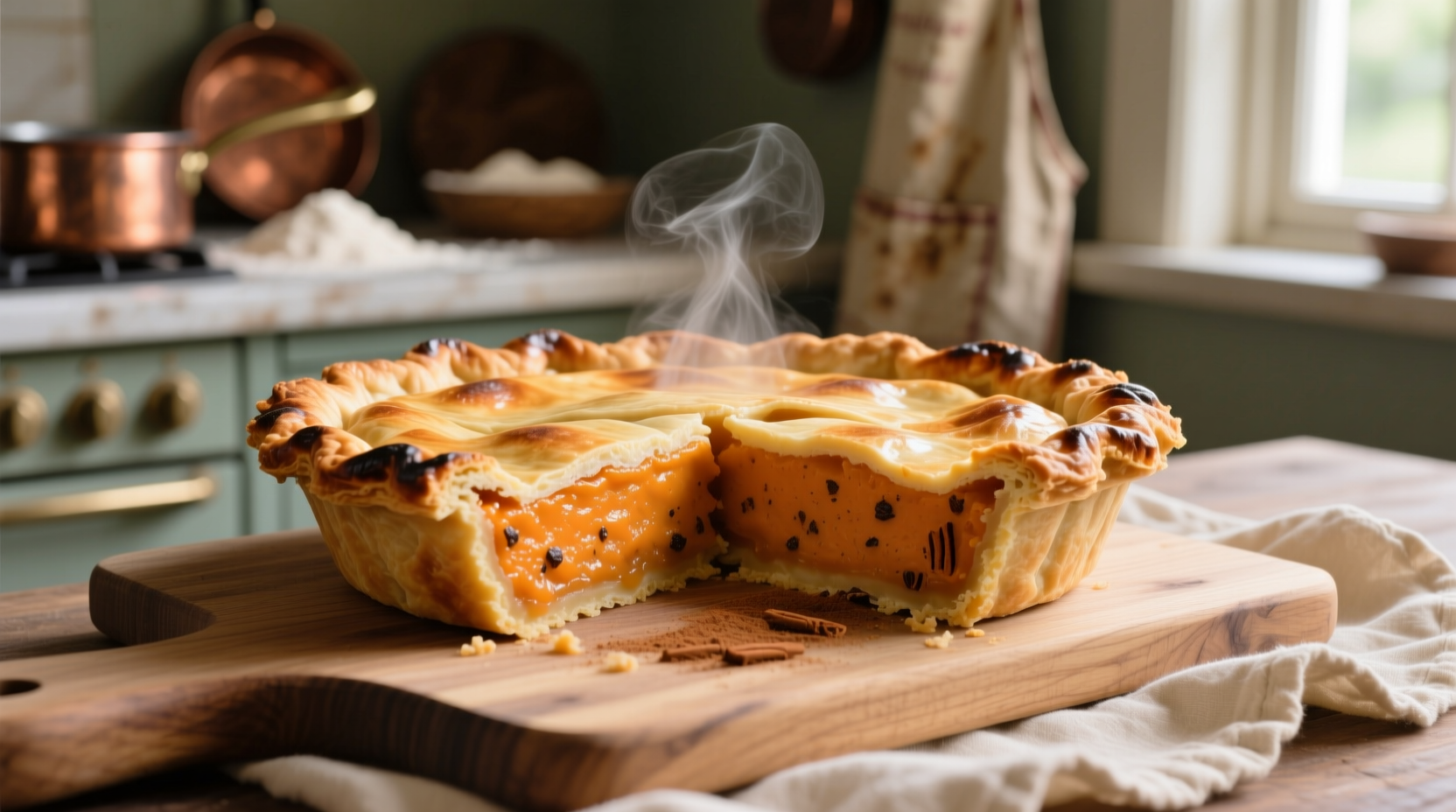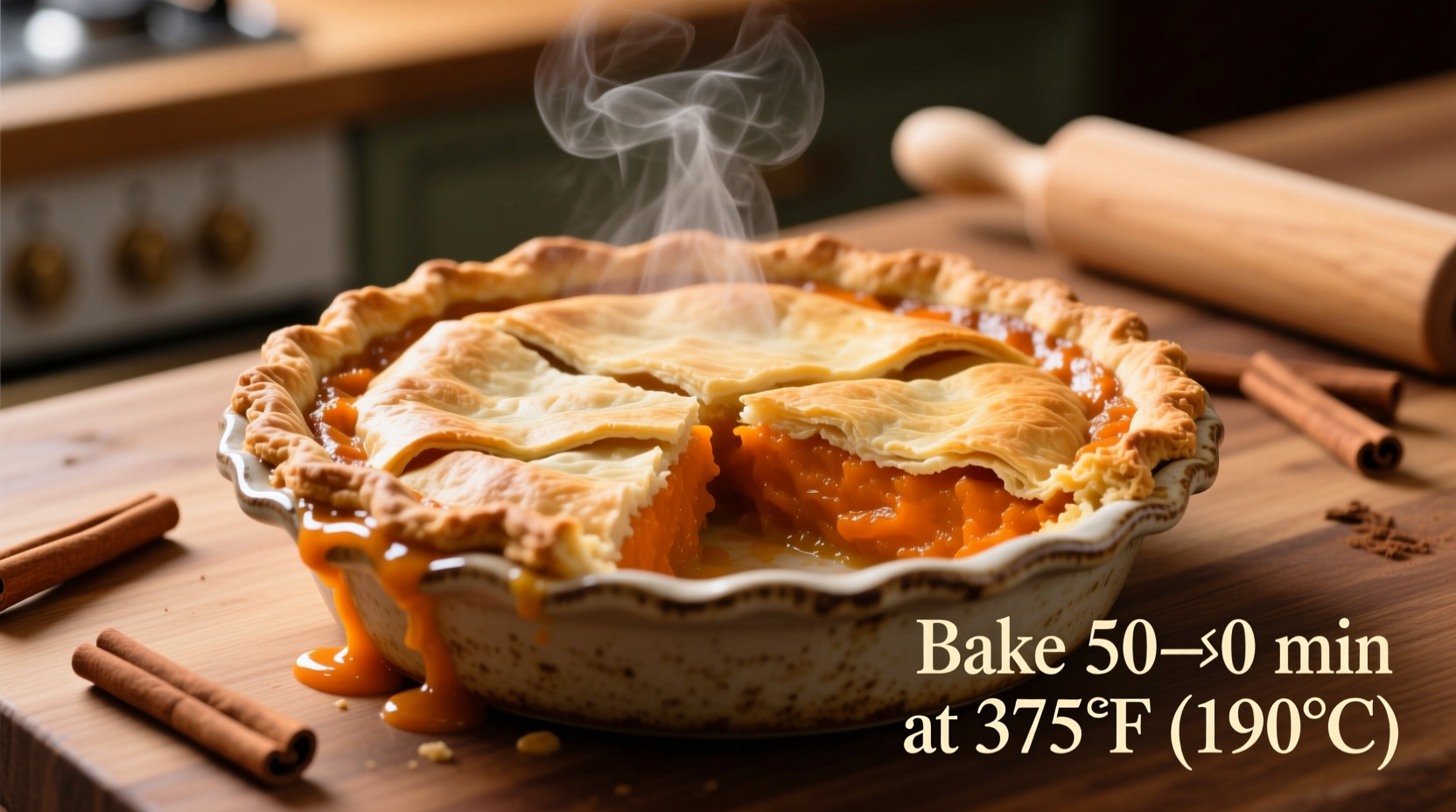Standard baking time for a 9-inch sweet potato pie is 50-60 minutes at 350°F (175°C). The pie is done when the center reaches 175-180°F and has a slight jiggle, with edges set and cracks beginning to form.
The Complete Guide to Perfect Sweet Potato Pie Baking Times
Nothing ruins a holiday dessert more than an undercooked or overbaked sweet potato pie. Getting the timing right ensures that perfect balance of creamy texture and fully developed flavors. Whether you're a first-time baker or a seasoned pro, understanding the precise baking duration for your sweet potato pie prevents common pitfalls that lead to cracked surfaces, runny fillings, or burnt crusts.
Why Standard Baking Times Vary
While most recipes suggest 50-60 minutes for a standard 9-inch pie, several factors influence your actual baking time. The USDA Food Safety and Inspection Service recommends that egg-based custard pies reach an internal temperature of 160°F for safety, but sweet potato pie requires slightly higher temperatures for optimal texture.
| Pie Size | Recommended Time | Internal Temp | Visual Cues |
|---|---|---|---|
| 9-inch standard | 50-60 minutes | 175-180°F | Edges set, slight center jiggle |
| Deep dish 9-inch | 60-70 minutes | 175-180°F | Surface cracks beginning to form |
| Mini pies (4-inch) | 25-35 minutes | 170-175°F | Filling appears set, no liquid movement |
Step-by-Step Baking Process
Preheating and Preparation (5 minutes)
Preheat your oven to 350°F (175°C) with the rack in the center position. This temperature provides the gentle, even heat needed for custard pies. According to America's Test Kitchen research, baking at higher temperatures causes the eggs to curdle while lower temperatures prevent proper setting.
Initial Baking Phase (First 30 minutes)
During the first half of baking, the pie's edges begin to set while the center remains liquid. This phase establishes the pie's structure. Avoid opening the oven during this critical period, as temperature fluctuations can cause cracking. King Arthur Baking Company's testing shows that oven door openings can create temperature drops of 25-50°F, significantly affecting baking consistency.

Setting Phase (30-50 minutes)
As baking continues, the center gradually thickens. The pie is approaching doneness when the edges are fully set but the center still has a slight jiggle—about the size of a quarter. This "jiggle test" is the most reliable visual indicator for sweet potato pie doneness, as recommended by professional baking instructors at The Culinary Institute of America.
Final Setting (50-60 minutes)
The last 10-15 minutes determine whether your pie achieves perfection or disaster. The center should reach 175-180°F when measured with an instant-read thermometer inserted in the center. At this temperature, the pie continues cooking from residual heat during cooling, reaching the ideal final texture. Baking beyond 185°F typically results in a curdled, watery filling.
How to Test for Perfect Doneness
Don't rely solely on the timer—use multiple indicators to determine when your sweet potato pie is perfectly baked:
- Temperature check: Insert an instant-read thermometer into the center; 175-180°F is ideal
- Jiggle test: Gently shake the pie; center should jiggle slightly like gelatin
- Surface appearance: Look for small cracks beginning to form on the surface
- Edge test: Edges should be fully set with no liquid movement when nudged
Cooling Time Matters Too
Many bakers don't realize that sweet potato pie continues cooking during the cooling process. Allow your pie to cool at room temperature for at least 2 hours before serving. This cooling period allows the filling to fully set and flavors to develop. Rushing this step often results in a runny pie, even if it appeared set when removed from the oven.
Troubleshooting Common Baking Issues
Pie is Undercooked
If your pie remains too liquid after the recommended time, return it to the oven for 5-10 minute increments. Check temperature frequently, as the pie can go from underdone to overdone quickly during this stage. The Food Network's baking experts note that high-moisture sweet potatoes can add 5-10 minutes to standard baking times.
Pie is Overcooked
Overbaking causes separation of liquids from the filling and large surface cracks. If this happens, try placing the pie in the refrigerator to help the filling reabsorb some moisture. For future attempts, reduce baking time by 5 minutes and rely more on temperature readings than visual cues alone.
Crust is Burning Before Filling Sets
This common issue occurs when oven temperature is too high or the pie is positioned too close to heating elements. Create a foil shield by folding a 12-inch square of aluminum foil over itself to create a ring that covers just the crust edges. Remove the shield during the last 15 minutes of baking to allow full browning.
Special Considerations for Different Ovens
Convection ovens typically require reducing the temperature by 25°F and checking 5-10 minutes earlier than standard recipes suggest. Gas ovens often have hotter bottom elements, so position your pie on the upper rack. Electric coil ovens maintain more consistent temperatures but may have hot spots—rotate the pie 180 degrees halfway through baking for even results.
Historical Evolution of Sweet Potato Pie Baking Times
Sweet potato pie has evolved significantly since its origins in early American cooking. In the 1800s, when most ovens were wood-fired with inconsistent temperatures, baking times varied wildly based on the cook's experience. The introduction of standardized oven temperatures in the early 20th century brought more consistency. According to research from the National Center for Home Food Preservation, modern baking times have shortened by about 15-20% compared to mid-20th century recommendations due to improvements in oven technology and better understanding of food science.
When Standard Times Don't Apply
Certain recipe variations require adjusted baking times:
- Marshmallow-topped pies: Add 5-10 minutes for the marshmallows to brown properly
- Vegan versions: Typically need 5-10 fewer minutes as egg substitutes set faster
- Extra-spiced recipes: High sugar content from additional sweeteners may require slightly lower temperatures
- Deep-dish variations: Add 10-15 minutes to ensure the center cooks through
Professional bakers at Williams-Sonoma note that humidity levels can affect baking times by as much as 10 minutes, with higher humidity requiring slightly longer baking to evaporate excess moisture from the filling.
Pro Tips for Perfect Results Every Time
- Let your pie filling come to room temperature before baking for more even cooking
- Place a baking sheet on the rack below to catch any potential spills and create more even heat
- Use a light-colored metal pan rather than dark glass for more consistent results
- Start checking for doneness 5 minutes before the minimum recommended time
- Allow the pie to cool completely before slicing for clean cuts











 浙公网安备
33010002000092号
浙公网安备
33010002000092号 浙B2-20120091-4
浙B2-20120091-4